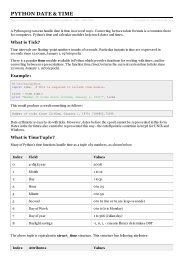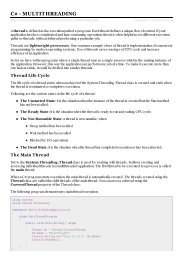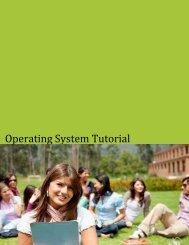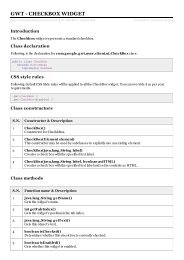Tutorials Point, Simply Easy Learning
Tutorials Point, Simply Easy Learning
Tutorials Point, Simply Easy Learning
Create successful ePaper yourself
Turn your PDF publications into a flip-book with our unique Google optimized e-Paper software.
<strong>Tutorials</strong> <strong>Point</strong>, <strong>Simply</strong> <strong>Easy</strong> <strong>Learning</strong><br />
PHP Tutorial<br />
<strong>Tutorials</strong>point.com<br />
The PHP Hypertext Pre-processor (PHP) is a programming language that allows web<br />
developers to create dynamic content that interacts with databases.<br />
PHP is basically used for developing web based software applications.<br />
This tutorial helps you to build your base with PHP.<br />
Send your feedback using Contact Us Form<br />
Audience:<br />
This tutorial is designed for PHP programmers who are completely unaware of PHP concepts but<br />
they have basic understanding on computer programming.<br />
Prerequisites:<br />
Before proceeding with this tutorial you should have at least basic understanding of computer<br />
programming, Internet, Database, and MySQL etc is very helpful.<br />
PHP Introduction<br />
1 | P a g e
<strong>Tutorials</strong> <strong>Point</strong>, <strong>Simply</strong> <strong>Easy</strong> <strong>Learning</strong><br />
PHP started out as a small open source project that evolved as more and more people found out<br />
how useful it was. Rasmus Lerdorf unleashed the first version of PHP way back in 1994.<br />
<br />
<br />
<br />
<br />
<br />
<br />
<br />
PHP is a recursive acronym for "PHP: Hypertext Preprocessor".<br />
PHP is a server side scripting language that is embedded in HTML. It is used to manage<br />
dynamic content, databases, session tracking, even build entire e-commerce sites.<br />
It is integrated with a number of popular databases, including MySQL, PostgreSQL,<br />
Oracle, Sybase, Informix, and Microsoft SQL Server.<br />
PHP is pleasingly zippy in its execution, especially when compiled as an Apache module<br />
on the Unix side. The MySQL server, once started, executes even very complex queries<br />
with huge result sets in record-setting time.<br />
PHP supports a large number of major protocols such as POP3, IMAP, and LDAP. PHP4<br />
added support for Java and distributed object architectures (COM and CORBA), making<br />
n-tier development a possibility for the first time.<br />
PHP is forgiving: PHP language tries to be as forgiving as possible.<br />
PHP Syntax is C-Like.<br />
Common uses of PHP:<br />
<br />
<br />
<br />
<br />
<br />
<br />
PHP performs system functions, i.e. from files on a system it can create, open, read,<br />
write, and close them.<br />
PHP can handle forms, i.e. gather data from files, save data to a file, thru email you can<br />
send data, return data to the user.<br />
You add, delete, modify elements within your database thru PHP.<br />
Access cookies variables and set cookies.<br />
Using PHP, you can restrict users to access some pages of your website.<br />
It can encrypt data.<br />
Characteristics of PHP<br />
Five important characteristics make PHP's practical nature possible:<br />
<br />
<br />
<br />
<br />
<br />
Simplicity<br />
Efficiency<br />
Security<br />
Flexibility<br />
Familiarity<br />
"Hello World" Script in PHP:<br />
To get a feel for PHP, first start with simple PHP scripts. Since "Hello, World!" is an essential<br />
example, first we will create a friendly little "Hello, World!" script.<br />
As mentioned earlier, PHP is embedded in HTML. That means that in amongst your normal HTML<br />
(or XHTML if you're cutting-edge) you'll have PHP statements like this:<br />
<br />
<br />
Hello World<br />
<br />
<br />
<br />
<br />
It will produce following result:<br />
2 | P a g e
<strong>Tutorials</strong> <strong>Point</strong>, <strong>Simply</strong> <strong>Easy</strong> <strong>Learning</strong><br />
Hello, World!<br />
If you examine the HTML output of the above example, you'll notice that the PHP code is not<br />
present in the file sent from the server to your Web browser. All of the PHP present in the Web<br />
page is processed and stripped from the page; the only thing returned to the client from the<br />
Web server is pure HTML output.<br />
All PHP code must be included inside one of the three special markup tags ate are recognised by<br />
the PHP Parser.<br />
<br />
<br />
PHP code goes here <br />
Most common tag is the and we will also use same tag in our tutorial.<br />
From the next chapter we will start with PHP Environment Setup on your machine and then we<br />
will dig out almost all concepts related to PHP to make you comfortable with the PHP language.<br />
PHP Environment Setup<br />
In order to develop and run PHP Web pages three vital components need to be installed on your<br />
computer system.<br />
<br />
<br />
<br />
Web Server - PHP will work with virtually all Web Server software, including Microsoft's<br />
Internet Information Server (IIS) but then most often used is freely availble Apache<br />
Server. Download Apache for free here: http://httpd.apache.org/download.cgi<br />
Database - PHP will work with virtually all database software, including Oracle and<br />
Sybase but most commonly used is freely available MySQL database. Download MySQL<br />
for free here: http://www.mysql.com/downloads/index.html<br />
PHP Parser - In order to process PHP script instructions a parser must be installed to<br />
generate HTML output that can be sent to the Web Browser. This tutorial will guide you<br />
how to install PHP parser on your computer.<br />
PHP Parser Installation:<br />
Before you proceed it is important to make sure that you have proper environment setup on<br />
your machine to develop your web programs using PHP.<br />
Type the following address into your browser's address box.<br />
http://127.0.0.1/info.php<br />
If this displays a page showing your PHP installation related information then it means you have<br />
PHP and Webserver installed properly. Otherwise you have to follow given procedure to install<br />
PHP on your computer.<br />
This section will guide you to install and configure PHP over the following four platforms:<br />
<br />
<br />
<br />
<br />
PHP Installation on Linux or Unix with Apache<br />
PHP Installation on Mac OS X with Apache<br />
PHP Installation on Windows NT/2000/XP with IIS<br />
PHP Installation on Windows NT/2000/XP with Apache<br />
3 | P a g e
<strong>Tutorials</strong> <strong>Point</strong>, <strong>Simply</strong> <strong>Easy</strong> <strong>Learning</strong><br />
Apache Configuration:<br />
If you are using Apache as a Web Server then this section will guide you to edit Apache<br />
Configuration Files.<br />
Just Check it here : PHP Configuration in Apache Server<br />
PHP.INI File Configuration:<br />
The PHP configuration file, php.ini, is the final and most immediate way to affect PHP's<br />
functionality.<br />
Just Check it here: PHP.INI File Configuration<br />
Windows IIS Configuration:<br />
To configure IIS on your Windows machine you can refer your IIS Reference Manual shipped<br />
along with IIS.<br />
PHP Syntax Overview<br />
This chapter will give you an idea of very basic syntax of PHP and very important to make your<br />
PHP foundation strong.<br />
Escaping to PHP:<br />
The PHP parsing engine needs a way to differentiate PHP code from other elements in the page.<br />
The mechanism for doing so is known as 'escaping to PHP.' There are four ways to do this:<br />
Canonical PHP tags:<br />
The most universally effective PHP tag style is:<br />
<br />
If you use this style, you can be positive that your tags will always be correctly interpreted.<br />
Short-open (SGML-style) tags:<br />
Short or short-open tags look like this:<br />
<br />
Short tags are, as one might expect, the shortest option You must do one of two things to<br />
enable PHP to recognize the tags:<br />
<br />
<br />
Choose the --enable-short-tags configuration option when you're building PHP.<br />
Set the short_open_tag setting in your php.ini file to on. This option must be disabled<br />
to parse XML with PHP because the same syntax is used for XML tags.<br />
ASP-style tags:<br />
4 | P a g e
<strong>Tutorials</strong> <strong>Point</strong>, <strong>Simply</strong> <strong>Easy</strong> <strong>Learning</strong><br />
ASP-style tags mimic the tags used by Active Server Pages to delineate code blocks. ASP-style<br />
tags look like this:<br />
<br />
To use ASP-style tags, you will need to set the configuration option in your php.ini file.<br />
HTML script tags:<br />
HTML script tags look like this:<br />
...<br />
Commenting PHP Code:<br />
A comment is the portion of a program that exists only for the human reader and stripped out<br />
before displaying the programs result. There are two commenting formats in PHP:<br />
Single-line comments: They are generally used for short explanations or notes relevant to the<br />
local code. Here are the examples of single line comments.<br />
<br />
Multi-lines printing: Here are the examples to print multiple lines in a single print statement:<br />
<br />
Multi-lines comments: They are generally used to provide pseudocode algorithms and more<br />
detailed explanations when necessary. The multiline style of commenting is the same as in C.<br />
Here are the example of multi lines comments.<br />
<strong>Tutorials</strong> <strong>Point</strong>, <strong>Simply</strong> <strong>Easy</strong> <strong>Learning</strong><br />
?><br />
PHP is whitespace insensitive:<br />
Whitespace is the stuff you type that is typically invisible on the screen, including spaces, tabs,<br />
and carriage returns (end-of-line characters).<br />
PHP whitespace insensitive means that it almost never matters how many whitespace<br />
characters you have in a row.one whitespace character is the same as many such characters<br />
For example, each of the following PHP statements that assigns the sum of 2 + 2 to the variable<br />
$four is equivalent:<br />
$four = 2 + 2; // single spaces<br />
$four =<br />
<br />
<br />
This will produce following result:<br />
Variable capital is 67<br />
Variable CaPiTaL is<br />
Statements are expressions terminated by semicolons:<br />
A statement in PHP is any expression that is followed by a semicolon (;).Any sequence of valid<br />
PHP statements that is enclosed by the PHP tags is a valid PHP program. Here is a typical<br />
statement in PHP, which in this case assigns a string of characters to a variable called<br />
$greeting:<br />
$greeting = "Welcome to PHP!";<br />
Expressions are combinations of tokens:<br />
The smallest building blocks of PHP are the indivisible tokens, such as numbers (3.14159),<br />
strings (.two.), variables ($two), constants (TRUE), and the special words that make up the<br />
syntax of PHP itself like if, else, while, for and so forth<br />
Braces make blocks:<br />
6 | P a g e
<strong>Tutorials</strong> <strong>Point</strong>, <strong>Simply</strong> <strong>Easy</strong> <strong>Learning</strong><br />
Although statements cannot be combined like expressions, you can always put a sequence of<br />
statements anywhere a statement can go by enclosing them in a set of curly braces.<br />
Here both statements are equivalent:<br />
if (3 == 2 + 1)<br />
print("Good - I haven't totally lost my mind.");<br />
if (3 == 2 + 1)<br />
{<br />
print("Good - I haven't totally");<br />
print("lost my mind.");<br />
}<br />
Running PHP Script from Command Prompt:<br />
Yes you can run your PHP script on your command prompt. Assuming you have following<br />
content in test.php file<br />
<br />
Now run this script as command prompt as follows:<br />
$ php test.php<br />
It will produce following result:<br />
Hello PHP!!!!!<br />
Hope now you have basic knowledge of PHP Syntax.<br />
PHP Variable Types<br />
The main way to store information in the middle of a PHP program is by using a variable.<br />
Here are the most important things to know about variables in PHP.<br />
All variables in PHP are denoted with a leading dollar sign ($).<br />
The value of a variable is the value of its most recent assignment.<br />
Variables are assigned with the = operator, with the variable on the left-hand side and<br />
the expression to be evaluated on the right.<br />
Variables can, but do not need, to be declared before assignment.<br />
Variables in PHP do not have intrinsic types - a variable does not know in advance<br />
whether it will be used to store a number or a string of characters.<br />
Variables used before they are assigned have default values.<br />
PHP does a good job of automatically converting types from one to another when<br />
necessary.<br />
PHP variables are Perl-like.<br />
PHP has a total of eight data types which we use to construct our variables:<br />
Integers: are whole numbers, without a decimal point, like 4195.<br />
7 | P a g e
<strong>Tutorials</strong> <strong>Point</strong>, <strong>Simply</strong> <strong>Easy</strong> <strong>Learning</strong><br />
Doubles: are floating-point numbers, like 3.14159 or 49.1.<br />
Booleans: have only two possible values either true or false.<br />
NULL: is a special type that only has one value: NULL.<br />
Strings: are sequences of characters, like 'PHP supports string operations.'<br />
Arrays: are named and indexed collections of other values.<br />
Objects: are instances of programmer-defined classes, which can package up both<br />
other kinds of values and functions that are specific to the class.<br />
Resources: are special variables that hold references to resources external to PHP<br />
(such as database connections).<br />
The first five are simple types, and the next two (arrays and objects) are compound - the<br />
compound types can package up other arbitrary values of arbitrary type, whereas the simple<br />
types cannot.<br />
We will explain only simile data type in this chapters. Array and Objects will be explained<br />
separately.<br />
Integers:<br />
They are whole numbers, without a decimal point, like 4195. They are the simplest type .they<br />
correspond to simple whole numbers, both positive and negative. Integers can be assigned to<br />
variables, or they can be used in expressions, like so:<br />
$int_var = 12345;<br />
$another_int = -12345 + 12345;<br />
Integer can be in decimal (base 10), octal (base 8), and hexadecimal (base 16) format. Decimal<br />
format is the default, octal integers are specified with a leading 0, and hexadecimals have a<br />
leading 0x.<br />
For most common platforms, the largest integer is (2**31 . 1) (or 2,147,483,647), and the<br />
smallest (most negative) integer is . (2**31 . 1) (or .2,147,483,647).<br />
Doubles:<br />
They like 3.14159 or 49.1. By default, doubles print with the minimum number of decimal<br />
places needed. For example, the code:<br />
$many = 2.2888800;<br />
$many_2 = 2.2111200;<br />
$few = $many + $many_2;<br />
print(.$many + $many_2 = $few.);<br />
It produces the following browser output:<br />
2.28888 + 2.21112 = 4.5<br />
Boolean:<br />
They have only two possible values either true or false. PHP provides a couple of constants<br />
especially for use as Booleans: TRUE and FALSE, which can be used like so:<br />
if (TRUE)<br />
print("This will always print");<br />
else<br />
8 | P a g e
<strong>Tutorials</strong> <strong>Point</strong>, <strong>Simply</strong> <strong>Easy</strong> <strong>Learning</strong><br />
print("This will never print");<br />
Interpreting other types as Booleans:<br />
Here are the rules for determine the "truth" of any value not already of the Boolean type:<br />
<br />
<br />
<br />
<br />
<br />
<br />
If the value is a number, it is false if exactly equal to zero and true otherwise.<br />
If the value is a string, it is false if the string is empty (has zero characters) or is the<br />
string "0", and is true otherwise.<br />
Values of type NULL are always false.<br />
If the value is an array, it is false if it contains no other values, and it is true otherwise.<br />
For an object, containing a value means having a member variable that has been<br />
assigned a value.<br />
Valid resources are true (although some functions that return resources when they are<br />
successful will return FALSE when unsuccessful).<br />
Don't use double as Booleans.<br />
Each of the following variables has the truth value embedded in its name when it is used in a<br />
Boolean context.<br />
$true_num = 3 + 0.14159;<br />
$true_str = "Tried and true"<br />
$true_array[49] = "An array element";<br />
$false_array = array();<br />
$false_null = NULL;<br />
$false_num = 999 - 999;<br />
$false_str = "";<br />
NULL:<br />
NULL is a special type that only has one value: NULL. To give a variable the NULL value, simply<br />
assign it like this:<br />
$my_var = NULL;<br />
The special constant NULL is capitalized by convention, but actually it is case insensitive; you<br />
could just as well have typed:<br />
$my_var = null;<br />
A variable that has been assigned NULL has the following properties:<br />
<br />
<br />
It evaluates to FALSE in a Boolean context.<br />
It returns FALSE when tested with IsSet() function.<br />
Strings:<br />
They are sequences of characters, like "PHP supports string operations". Following are valid<br />
examples of string<br />
$string_1 = "This is a string in double quotes";<br />
$string_2 = "This is a somewhat longer, singly quoted string";<br />
$string_39 = "This string has thirty-nine characters";<br />
$string_0 = ""; // a string with zero characters<br />
9 | P a g e
<strong>Tutorials</strong> <strong>Point</strong>, <strong>Simply</strong> <strong>Easy</strong> <strong>Learning</strong><br />
Singly quoted strings are treated almost literally, whereas doubly quoted strings replace<br />
variables with their values as well as specially interpreting certain character sequences.<br />
<br />
This will produce following result:<br />
My $variable will not print!\n<br />
My name will print<br />
There are no artificial limits on string length - within the bounds of available memory, you ought<br />
to be able to make arbitrarily long strings.<br />
Strings that are delimited by double quotes (as in "this") are preprocessed in both the following<br />
two ways by PHP:<br />
<br />
<br />
Certain character sequences beginning with backslash (\) are replaced with special<br />
characters<br />
Variable names (starting with $) are replaced with string representations of their<br />
values.<br />
The escape-sequence replacements are:<br />
\n is replaced by the newline character<br />
\r is replaced by the carriage-return character<br />
\t is replaced by the tab character<br />
\$ is replaced by the dollar sign itself ($)<br />
\" is replaced by a single double-quote (")<br />
\\ is replaced by a single backslash (\)<br />
Here Document:<br />
You can assign multiple lines to a single string variable using here document:<br />
<strong>Tutorials</strong> <strong>Point</strong>, <strong>Simply</strong> <strong>Easy</strong> <strong>Learning</strong><br />
END;<br />
print $channel;<br />
?><br />
This will produce following result:<br />
This uses the "here document" syntax to output<br />
multiple lines with variable interpolation. Note<br />
that the here document terminator must appear on a<br />
line with just a semicolon. no extra whitespace!<br />
<br />
What's For Dinner<br />
http://menu.example.com/<br />
Choose what to eat tonight.<br />
Variable Scope:<br />
Scope can be defined as the range of availability a variable has to the program in which it is<br />
declared. PHP variables can be one of four scope types:<br />
<br />
<br />
<br />
<br />
Local variables<br />
Function parameters<br />
Global variables<br />
Static variables<br />
Variable Naming:<br />
Rules for naming a variable is:<br />
<br />
<br />
Variable names must begin with a letter or underscore character.<br />
A variable name can consist of numbers, letters, underscores but you cannot use<br />
characters like + , - , % , ( , ) . & , etc<br />
There is no size limit for variables.<br />
PHP Constants<br />
A constant is a name or an identifier for a simple value. A constant value cannot change during<br />
the execution of the script. By default a constant is case-sensitive. By convention, constant<br />
identifiers are always uppercase. A constant name starts with a letter or underscore, followed by<br />
any number of letters, numbers, or underscores. If you have defined a constant, it can never be<br />
changed or undefined.<br />
To define a constant you have to use define() function and to retrieve the value of a constant,<br />
you have to simply specifying its name. Unlike with variables, you do not need to have a<br />
constant with a $. You can also use the function constant() to read a constant's value if you<br />
wish to obtain the constant's name dynamically.<br />
constant() function:<br />
As indicated by the name, this function will return the value of the constant.<br />
This is useful when you want to retrieve value of a constant, but you do not know its name, i.e.<br />
It is stored in a variable or returned by a function.<br />
11 | P a g e
<strong>Tutorials</strong> <strong>Point</strong>, <strong>Simply</strong> <strong>Easy</strong> <strong>Learning</strong><br />
constant() example:<br />
<br />
Only scalar data (boolean, integer, float and string) can be contained in constants.<br />
Differences between constants and variables are:<br />
<br />
<br />
<br />
<br />
There is no need to write a dollar sign ($) before a constant, where as in Variable one<br />
has to write a dollar sign.<br />
Constants cannot be defined by simple assignment, they may only be defined using the<br />
define() function.<br />
Constants may be defined and accessed anywhere without regard to variable scoping<br />
rules.<br />
Once the Constants have been set, may not be redefined or undefined.<br />
Valid and invalid constant names:<br />
// Valid constant names<br />
define("ONE", "first thing");<br />
define("TWO2", "second thing");<br />
define("THREE_3", "third thing")<br />
// Invalid constant names<br />
define("2TWO", "second thing");<br />
define("__THREE__", "third value");<br />
PHP Magic constants:<br />
PHP provides a large number of predefined constants to any script which it runs.<br />
There are five magical constants that change depending on where they are used. For example,<br />
the value of __LINE__ depends on the line that it's used on in your script. These special<br />
constants are case-insensitive and are as follows:<br />
A few "magical" PHP constants ate given below:<br />
Name<br />
Description<br />
__LINE__<br />
The current line number of the file.<br />
__FILE__<br />
The full path and filename of the file. If used inside an include,the name of<br />
the included file is returned. Since PHP 4.0.2, __FILE__ always contains<br />
an absolute path whereas in older versions it contained relative path under<br />
some circumstances.<br />
__FUNCTION__ The function name. (Added in PHP 4.3.0) As of PHP 5 this constant returns<br />
the function name as it was declared (case-sensitive). In PHP 4 its value is<br />
12 | P a g e
<strong>Tutorials</strong> <strong>Point</strong>, <strong>Simply</strong> <strong>Easy</strong> <strong>Learning</strong><br />
always lowercased.<br />
__CLASS__<br />
The class name. (Added in PHP 4.3.0) As of PHP 5 this constant returns the<br />
class name as it was declared (case-sensitive). In PHP 4 its value is always<br />
lowercased.<br />
__METHOD__<br />
The class method name. (Added in PHP 5.0.0) The method name is<br />
returned as it was declared (case-sensitive).<br />
PHP Operator Types<br />
What is Operator? Simple answer can be given using expression 4 + 5 is equal to 9. Here 4<br />
and 5 are called operands and + is called operator. PHP language supports following type of<br />
operators.<br />
<br />
<br />
<br />
<br />
<br />
Arithmetic Operators<br />
Comparision Operators<br />
Logical (or Relational) Operators<br />
Assignment Operators<br />
Conditional (or ternary) Operators<br />
Lets have a look on all operators one by one.<br />
Arithmatic Operators:<br />
There are following arithmatic operators supported by PHP language:<br />
Assume variable A holds 10 and variable B holds 20 then:<br />
Show Examples<br />
Operator Description Example<br />
+ Adds two operands A + B will give 30<br />
- Subtracts second operand from the first A - B will give -10<br />
* Multiply both operands A * B will give 200<br />
/ Divide numerator by denumerator B / A will give 2<br />
% Modulus Operator and remainder of<br />
after an integer division<br />
B % A will give 0<br />
++ Increment operator, increases integer<br />
value by one<br />
A++ will give 11<br />
13 | P a g e
<strong>Tutorials</strong> <strong>Point</strong>, <strong>Simply</strong> <strong>Easy</strong> <strong>Learning</strong><br />
-- Decrement operator, decreases integer<br />
value by one<br />
A-- will give 9<br />
Comparison Operators:<br />
There are following comparison operators supported by PHP language<br />
Assume variable A holds 10 and variable B holds 20 then:<br />
Show Examples<br />
Operator Description Example<br />
== Checks if the value of two operands are<br />
equal or not, if yes then condition<br />
becomes true.<br />
(A == B) is not true.<br />
!= Checks if the value of two operands are<br />
equal or not, if values are not equal<br />
then condition becomes true.<br />
(A != B) is true.<br />
> Checks if the value of left operand is<br />
greater than the value of right operand,<br />
if yes then condition becomes true.<br />
(A > B) is not true.<br />
< Checks if the value of left operand is<br />
less than the value of right operand, if<br />
yes then condition becomes true.<br />
(A < B) is true.<br />
>= Checks if the value of left operand is<br />
greater than or equal to the value of<br />
right operand, if yes then condition<br />
becomes true.<br />
(A >= B) is not true.<br />
<strong>Tutorials</strong> <strong>Point</strong>, <strong>Simply</strong> <strong>Easy</strong> <strong>Learning</strong><br />
Operator Description Example<br />
and<br />
Called Logical AND operator. If both the<br />
operands are true then then condition<br />
becomes true.<br />
(A and B) is true.<br />
or<br />
Called Logical OR Operator. If any of<br />
the two operands are non zero then<br />
then condition becomes true.<br />
(A or B) is true.<br />
&&<br />
Called Logical AND operator. If both the<br />
operands are non zero then then<br />
condition becomes true.<br />
(A && B) is true.<br />
|| Called Logical OR Operator. If any of<br />
the two operands are non zero then<br />
then condition becomes true.<br />
(A || B) is true.<br />
! Called Logical NOT Operator. Use to<br />
reverses the logical state of its<br />
operand. If a condition is true then<br />
Logical NOT operator will make false.<br />
!(A && B) is false.<br />
Assignment Operators:<br />
There are following assignment operators supported by PHP language:<br />
Show Examples<br />
Operator Description Example<br />
= Simple assignment operator,<br />
Assigns values from right side<br />
operands to left side operand<br />
C = A + B will assigne value of A + B into C<br />
+= Add AND assignment operator, It<br />
adds right operand to the left<br />
operand and assign the result to<br />
left operand<br />
C += A is equivalent to C = C + A<br />
-= Subtract AND assignment<br />
operator, It subtracts right<br />
operand from the left operand and<br />
assign the result to left operand<br />
C -= A is equivalent to C = C - A<br />
*= Multiply AND assignment operator,<br />
It multiplies right operand with the<br />
left operand and assign the result<br />
C *= A is equivalent to C = C * A<br />
15 | P a g e
<strong>Tutorials</strong> <strong>Point</strong>, <strong>Simply</strong> <strong>Easy</strong> <strong>Learning</strong><br />
to left operand<br />
/= Divide AND assignment operator,<br />
It divides left operand with the<br />
right operand and assign the result<br />
to left operand<br />
C /= A is equivalent to C = C / A<br />
%= Modulus AND assignment operator,<br />
It takes modulus using two<br />
operands and assign the result to<br />
left operand<br />
C %= A is equivalent to C = C % A<br />
Conditional Operator<br />
There is one more operator called conditional operator. This first evaluates an expression for a<br />
true or false value and then execute one of the two given statements depending upon the result<br />
of the evaluation. The conditional operator has this syntax:<br />
Show Examples<br />
Operator Description Example<br />
? : Conditional Expression If Condition is true ? Then value X :<br />
Otherwise value Y<br />
Operators Categories:<br />
All the operators we have discussed above can be categorised into following categories:<br />
<br />
<br />
<br />
<br />
Unary prefix operators, which precede a single operand.<br />
Binary operators, which take two operands and perform a variety of arithmetic and<br />
logical operations.<br />
The conditional operator (a ternary operator), which takes three operands and<br />
evaluates either the second or third expression, depending on the evaluation of the first<br />
expression.<br />
Assignment operators, which assign a value to a variable.<br />
Precedence of PHP Operators:<br />
Operator precedence determines the grouping of terms in an expression. This affects how an<br />
expression is evaluated. Certain operators have higher precedence than others; for example,<br />
the multiplication operator has higher precedence than the addition operator:<br />
For example x = 7 + 3 * 2; Here x is assigned 13, not 20 because operator * has higher<br />
precedenace than + so it first get multiplied with 3*2 and then adds into 7.<br />
Here operators with the highest precedence appear at the top of the table, those with the lowest<br />
appear at the bottom. Within an expression, higher precedence operators will be evaluated first.<br />
Category Operator Associativity<br />
16 | P a g e
<strong>Tutorials</strong> <strong>Point</strong>, <strong>Simply</strong> <strong>Easy</strong> <strong>Learning</strong><br />
Unary ! ++ -- Right to left<br />
Multiplicative * / % Left to right<br />
Additive + - Left to right<br />
Relational < >= Left to right<br />
Equality == != Left to right<br />
Logical AND && Left to right<br />
Logical OR || Left to right<br />
Conditional ?: Right to left<br />
Assignment = += -= *= /=<br />
PHP Decision Making<br />
The if, elseif ...else and switch statements are used to take decision based on the different<br />
condition.<br />
You can use conditional statements in your code to make your decisions. PHP supports following<br />
threedecision making statements:<br />
<br />
<br />
<br />
if...else statement - use this statement if you want to execute a set of code when a<br />
condition is true and another if the condition is not true<br />
elseif statement - is used with the if...else statement to execute a set of code<br />
if one of several condition are true<br />
switch statement - is used if you want to select one of many blocks of code to be<br />
executed, use the Switch statement. The switch statement is used to avoid long blocks<br />
of if..elseif..else code.<br />
The If...Else Statement<br />
If you want to execute some code if a condition is true and another code if a condition is false,<br />
use the if....else statement.<br />
Syntax<br />
if (condition)<br />
code to be executed if condition is true;<br />
else<br />
code to be executed if condition is false;<br />
Example<br />
The following example will output "Have a nice weekend!" if the current day is Friday, otherwise<br />
it will output "Have a nice day!":<br />
17 | P a g e
<strong>Tutorials</strong> <strong>Point</strong>, <strong>Simply</strong> <strong>Easy</strong> <strong>Learning</strong><br />
<br />
<br />
<br />
<br />
<br />
If more than one line should be executed if a condition is true/false, the lines should be<br />
enclosed within curly braces:<br />
<br />
<br />
<br />
<br />
<br />
The ElseIf Statement<br />
If you want to execute some code if one of several conditions are true use the elseif statement<br />
Syntax<br />
if (condition)<br />
code to be executed if condition is true;<br />
elseif (condition)<br />
code to be executed if condition is true;<br />
else<br />
code to be executed if condition is false;<br />
Example<br />
The following example will output "Have a nice weekend!" if the current day is Friday, and "Have<br />
a nice Sunday!" if the current day is Sunday. Otherwise it will output "Have a nice day!":<br />
<br />
<br />
<br />
<br />
<br />
18 | P a g e
<strong>Tutorials</strong> <strong>Point</strong>, <strong>Simply</strong> <strong>Easy</strong> <strong>Learning</strong><br />
The Switch Statement<br />
If you want to select one of many blocks of code to be executed, use the Switch statement.<br />
The switch statement is used to avoid long blocks of if..elseif..else code.<br />
Syntax<br />
switch (expression)<br />
{<br />
case label1:<br />
code to be executed if expression = label1;<br />
break;<br />
case label2:<br />
code to be executed if expression = label2;<br />
break;<br />
default:<br />
code to be executed<br />
if expression is different<br />
from both label1 and label2;<br />
}<br />
Example<br />
The switch statement works in an unusual way. First it evaluates given expression then seeks a<br />
lable to match the resulting value. If a matching value is found then the code associated with<br />
the matching label will be executed or if none of the lables match then statement will execute<br />
any specified default code.<br />
<br />
<br />
<br />
<br />
19 | P a g e
<strong>Tutorials</strong> <strong>Point</strong>, <strong>Simply</strong> <strong>Easy</strong> <strong>Learning</strong><br />
<br />
PHP Loop Types<br />
Loops in PHP are used to execute the same block of code a specified number of times. PHP<br />
supports following four loop types.<br />
<br />
<br />
<br />
<br />
for - loops through a block of code a specified number of times.<br />
while - loops through a block of code if and as long as a specified condition is true.<br />
do...while - loops through a block of code once, and then repeats the loop as long as a<br />
special condition is trur.<br />
foreach - loops through a block of code for each element in an array.<br />
We will discuss about continue and break keywords used to control the loops execution.<br />
The for loop statement<br />
The for statement is used when you know how many times you want to execute a statement or<br />
a block of statements.<br />
Syntax<br />
for (initialization; condition; increment)<br />
{<br />
code to be executed;<br />
}<br />
The initializer is used to set the start value for the counter of the number of loop iterations. A<br />
variable may be declared here for this purpose and it is traditional to name it $i.<br />
Example<br />
The following example makes five iterations and changes the assigned value of two variables on<br />
each pass of the loop:<br />
<br />
<br />
<br />
<br />
<br />
This will produce following result:<br />
At the end of the loop a=50 and b=25<br />
20 | P a g e
<strong>Tutorials</strong> <strong>Point</strong>, <strong>Simply</strong> <strong>Easy</strong> <strong>Learning</strong><br />
The while loop statement<br />
The while statement will execute a block of code if and as long as a test expression is true.<br />
If the test expression is true then the code block will be executed. After the code has executed<br />
the test expression will again be evaluated and the loop will continue until the test expression is<br />
found to be false.<br />
Syntax<br />
while (condition)<br />
{<br />
code to be executed;<br />
}<br />
Example<br />
This example decrements a variable value on each iteration of the loop and the counter<br />
increments until it reaches 10 when the evaluation is false and the loop ends.<br />
<br />
<br />
<br />
<br />
<br />
This will produce following result:<br />
Loop stopped at i = 1 and num = 40<br />
The do...while loop statement<br />
The do...while statement will execute a block of code at least once - it then will repeat the loop<br />
as long as a condition is true.<br />
Syntax<br />
do<br />
{<br />
code to be executed;<br />
}while (condition);<br />
Example<br />
The following example will increment the value of i at least once, and it will continue<br />
incrementing the variable i as long as it has a value of less than 10:<br />
21 | P a g e
<strong>Tutorials</strong> <strong>Point</strong>, <strong>Simply</strong> <strong>Easy</strong> <strong>Learning</strong><br />
<br />
<br />
<br />
<br />
<br />
This will produce following result:<br />
Loop stopped at i = 10<br />
The foreach loop statement<br />
The foreach statement is used to loop through arrays. For each pass the value of the current<br />
array element is assigned to $value and the array pointer is moved by one and in the next pass<br />
next element will be processed.<br />
Syntax<br />
foreach (array as value)<br />
{<br />
code to be executed;<br />
}<br />
Example<br />
Try out following example to list out the values of an array.<br />
<br />
<br />
<br />
<br />
<br />
This will produce following result:<br />
Value is 1<br />
Value is 2<br />
Value is 3<br />
Value is 4<br />
Value is 5<br />
22 | P a g e
<strong>Tutorials</strong> <strong>Point</strong>, <strong>Simply</strong> <strong>Easy</strong> <strong>Learning</strong><br />
The break statement<br />
The PHP break keyword is used to terminate the execution of a loop prematurely.<br />
The break statement is situated inside the statement block. If gives you full control and<br />
whenever you want to exit from the loop you can come out. After coming out of a loop<br />
immediate statement to the loop will be executed.<br />
Example<br />
In the following example condition test becomes true when the counter value reaches 3 and<br />
loop terminates.<br />
<br />
<br />
<br />
<br />
<br />
This will produce following result:<br />
Loop stopped at i = 3<br />
The continue statement<br />
The PHP continue keyword is used to halt the current iteration of a loop but it does not<br />
terminate the loop.<br />
Just like the break statement the continue statement is situated inside the statement block<br />
containing the code that the loop executes, preceded by a conditional test. For the pass<br />
encountering continue statement, rest of the loop code is skipped and next pass starts.<br />
Example<br />
In the following example loop prints the value of array but for which condition becomes true it<br />
just skip the code and next value is printed.<br />
<br />
<br />
<strong>Tutorials</strong> <strong>Point</strong>, <strong>Simply</strong> <strong>Easy</strong> <strong>Learning</strong><br />
}<br />
?><br />
<br />
<br />
This will produce following result<br />
Value is 1<br />
Value is 2<br />
Value is 4<br />
Value is 5<br />
PHP Arrays<br />
An array is a data structure that stores one or more similar type of values in a single value. For<br />
example if you want to store 100 numbers then instead of defining 100 variables its easy to<br />
define an array of 100 length.<br />
There are three different kind of arrays and each array value is accessed using an ID c which is<br />
called array index.<br />
<br />
<br />
<br />
Numeric array - An array with a numeric index. Values are stored and accessed in<br />
linear fashion<br />
Associative array - An array with strings as index. This stores element values in<br />
association with key values rather than in a strict linear index order.<br />
Multidimensional array - An array containing one or more arrays and values are<br />
accessed using multiple indices<br />
NOTE: Built-in array functions is given in function reference PHP Array Functions<br />
Numeric Array<br />
These arrays can store numbers, strings and any object but their index will be prepresented by<br />
numbers. By default array index starts from zero.<br />
Example<br />
Following is the example showing how to create and access numeric arrays.<br />
Here we have used array() function to create array. This function is explained in function<br />
reference.<br />
<br />
<br />
<strong>Tutorials</strong> <strong>Point</strong>, <strong>Simply</strong> <strong>Easy</strong> <strong>Learning</strong><br />
$numbers[2] = "three";<br />
$numbers[3] = "four";<br />
$numbers[4] = "five";<br />
foreach( $numbers as $value )<br />
{<br />
echo "Value is $value ";<br />
}<br />
?><br />
<br />
<br />
This will produce following result:<br />
Value is 1<br />
Value is 2<br />
Value is 3<br />
Value is 4<br />
Value is 5<br />
Value is one<br />
Value is two<br />
Value is three<br />
Value is four<br />
Value is five<br />
Associative Arrays<br />
The associative arrays are very similar to numeric arrays in term of functionality but they are<br />
different in terms of their index. Associative array will have their index as string so that you can<br />
establish a strong association between key and values.<br />
To store the salaries of employees in an array, a numerically indexed array would not be the<br />
best choice. Instead, we could use the employees names as the keys in our associative array,<br />
and the value would be their respective salary.<br />
NOTE: Don't keep associative array inside double quote while printing otheriwse it would not<br />
return any value.<br />
Example<br />
<br />
<br />
<strong>Tutorials</strong> <strong>Point</strong>, <strong>Simply</strong> <strong>Easy</strong> <strong>Learning</strong><br />
echo "Salary of zara is ". $salaries['zara']. "";<br />
?><br />
<br />
<br />
This will produce following result:<br />
Salary of mohammad is 2000<br />
Salary of qadir is 1000<br />
Salary of zara is 500<br />
Salary of mohammad is high<br />
Salary of qadir is medium<br />
Salary of zara is low<br />
Multidimensional Arrays<br />
A multi-dimensional array each element in the main array can also be an array. And each<br />
element in the sub-array can be an array, and so on. Values in the multi-dimensional array are<br />
accessed using multiple index.<br />
Example<br />
In this example we create a two dimensional array to store marks of three students in three<br />
subjects:<br />
This example is an associative array, you can create numeric array in the same fashion.<br />
<br />
<br />
<br />
<br />
<br />
26 | P a g e
<strong>Tutorials</strong> <strong>Point</strong>, <strong>Simply</strong> <strong>Easy</strong> <strong>Learning</strong><br />
This will produce following result:<br />
Marks for mohammad in physics : 35<br />
Marks for qadir in maths : 32<br />
Marks for zara in chemistry : 39<br />
PHP Strings<br />
They are sequences of characters, like "PHP supports string operations".<br />
NOTE: Built-in string functions is given in function reference PHP String Functions<br />
Following are valid examples of string<br />
$string_1 = "This is a string in double quotes";<br />
$string_2 = "This is a somewhat longer, singly quoted string";<br />
$string_39 = "This string has thirty-nine characters";<br />
$string_0 = ""; // a string with zero characters<br />
Singly quoted strings are treated almost literally, whereas doubly quoted strings replace<br />
variables with their values as well as specially interpreting certain character sequences.<br />
<br />
This will produce following result:<br />
My $variable will not print!\n<br />
My name will print<br />
There are no artificial limits on string length - within the bounds of available memory, you ought<br />
to be able to make arbitrarily long strings.<br />
Strings that are delimited by double quotes (as in "this") are preprocessed in both the following<br />
two ways by PHP:<br />
<br />
<br />
Certain character sequences beginning with backslash (\) are replaced with special<br />
characters<br />
Variable names (starting with $) are replaced with string representations of their<br />
values.<br />
The escape-sequence replacements are:<br />
\n is replaced by the newline character<br />
\r is replaced by the carriage-return character<br />
\t is replaced by the tab character<br />
\$ is replaced by the dollar sign itself ($)<br />
\" is replaced by a single double-quote (")<br />
27 | P a g e
<strong>Tutorials</strong> <strong>Point</strong>, <strong>Simply</strong> <strong>Easy</strong> <strong>Learning</strong><br />
\\ is replaced by a single backslash (\)<br />
String Concatenation Operator<br />
To concatenate two string variables together, use the dot (.) operator:<br />
<br />
This will produce following result:<br />
Hello World 1234<br />
If we look at the code above you see that we used the concatenation operator two times. This is<br />
because we had to insert a third string.<br />
Between the two string variables we added a string with a single character, an empty space, to<br />
separate the two variables.<br />
Using the strlen() function<br />
The strlen() function is used to find the length of a string.<br />
Let's find the length of our string "Hello world!":<br />
<br />
This will produce following result:<br />
12<br />
The length of a string is often used in loops or other functions, when it is important to know<br />
when the string ends. (i.e. in a loop, we would want to stop the loop after the last character in<br />
the string)<br />
Using the strpos() function<br />
The strpos() function is used to search for a string or character within a string.<br />
If a match is found in the string, this function will return the position of the first match. If no<br />
match is found, it will return FALSE.<br />
Let's see if we can find the string "world" in our string:<br />
<br />
28 | P a g e
<strong>Tutorials</strong> <strong>Point</strong>, <strong>Simply</strong> <strong>Easy</strong> <strong>Learning</strong><br />
This will produce following result:<br />
6<br />
As you see the position of the string "world" in our string is position 6. The reason that it is 6,<br />
and not 7, is that the first position in the string is 0, and not 1.<br />
PHP File Inclusion<br />
You can include the content of a PHP file into another PHP file before the server executes it.<br />
There are two PHP functions which can be used to included one PHP file into another PHP file.<br />
<br />
<br />
The include() Function<br />
The require() Function<br />
This is a strong point of PHP which helps in creating functions, headers, footers, or elements<br />
that can be reused on multiple pages. This will help developers to make it easy to change the<br />
layout of complete website with minimal effort. If there is any change required then instead of<br />
changing thousand of files just change included file.<br />
The include() Function<br />
The include() function takes all the text in a specified file and copies it into the file that uses the<br />
include function. If there is any problem in loading a file then the include() function generates<br />
a warning but the script will continue execution.<br />
Assume you want to create a common menu for your website. Then create a file menu.php with<br />
the following content.<br />
Home -<br />
ebXML -<br />
AJAX -<br />
PERL <br />
Now create as many pages as you like and include this file to create header. For example now<br />
your test.php file can have following content.<br />
<br />
<br />
<br />
This is an example to show how to include PHP file!<br />
<br />
<br />
This will produce following result<br />
Home - ebXML - AJAX - PERL<br />
This is an example to show how to include PHP file. You can include mean.php file in as many<br />
as files you like!<br />
The require() Function<br />
The require() function takes all the text in a specified file and copies it into the file that uses the<br />
29 | P a g e
<strong>Tutorials</strong> <strong>Point</strong>, <strong>Simply</strong> <strong>Easy</strong> <strong>Learning</strong><br />
include function. If there is any problem in loading a file then the require() function generates<br />
a fatal error and halt the excution of the script.<br />
So there is no difference in require() and include() except they handle error conditions. It is<br />
recommended to use the require() function instead of include(), because scripts should not<br />
continue executing if files are missing or misnamed.<br />
You can try using above example with require() function and it will generate same result. But if<br />
you will try following two examples where file does not exist then you will get different results.<br />
<br />
<br />
<br />
This is an example to show how to include wrong PHP file!<br />
<br />
<br />
This will produce following result<br />
This is an example to show how to include wrong PHP file!<br />
Now lets try same example with require() function.<br />
<br />
<br />
<br />
This is an example to show how to include wrong PHP file!<br />
<br />
<br />
This time file execution halts and nothing is displayed.<br />
NOTE: You may get plain warning messages or fatal error messages or nothing at all. This<br />
depends on your PHP Server configuration.<br />
PHP Files & I/O<br />
This chapter will explain following functions related to files:<br />
<br />
<br />
<br />
<br />
Opening a file<br />
Reading a file<br />
Writing a file<br />
Closing a file<br />
Opening and Closing Files<br />
The PHP fopen() function is used to open a file. It requires two arguments stating first the file<br />
name and then mode in which to operate.<br />
Files modes can be specified as one of the six options in this table.<br />
Mode<br />
Purpose<br />
30 | P a g e
<strong>Tutorials</strong> <strong>Point</strong>, <strong>Simply</strong> <strong>Easy</strong> <strong>Learning</strong><br />
r<br />
Opens the file for reading only.<br />
Places the file pointer at the beginning of the file.<br />
r+ Opens the file for reading and writing.<br />
Places the file pointer at the beginning of the file.<br />
w<br />
Opens the file for writing only.<br />
Places the file pointer at the beginning of the file.<br />
and truncates the file to zero length. If files does not<br />
exist then it attemts to create a file.<br />
w+ Opens the file for reading and writing only.<br />
Places the file pointer at the beginning of the file.<br />
and truncates the file to zero length. If files does not<br />
exist then it attemts to create a file.<br />
a<br />
Opens the file for writing only.<br />
Places the file pointer at the end of the file.<br />
If files does not exist then it attemts to create a file.<br />
a+ Opens the file for reading and writing only.<br />
Places the file pointer at the end of the file.<br />
If files does not exist then it attemts to create a file.<br />
If an attempt to open a file fails then fopen returns a value of false otherwise it returns a file<br />
pointer which is used for further reading or writing to that file.<br />
After making a changes to the opened file it is important to close it with the fclose() function.<br />
The fclose() function requires a file pointer as its argument and then returns true when the<br />
closure succeeds or false if it fails.<br />
Reading a file<br />
Once a file is opened using fopen() function it can be read with a function called fread(). This<br />
function requires two arguments. These must be the file pointer and the length of the file<br />
expressed in bytes.<br />
The files's length can be found using the filesize() function which takes the file name as its<br />
argument and returns the size of the file expressed in bytes.<br />
So here are the steps required to read a file with PHP.<br />
<br />
<br />
<br />
<br />
Open a file using fopen() function.<br />
Get the file's length using filesize() function.<br />
Read the file's content using fread() function.<br />
Close the file with fclose() function.<br />
The following example assigns the content of a text file to a variable then displays those<br />
contents on the web page.<br />
<br />
31 | P a g e
<strong>Tutorials</strong> <strong>Point</strong>, <strong>Simply</strong> <strong>Easy</strong> <strong>Learning</strong><br />
<br />
Reading a file using PHP<br />
<br />
<br />
<br />
<br />
<br />
Writing a file<br />
A new file can be written or text can be appended to an existing file using the<br />
PHP fwrite()function. This function requires two arguments specifying a file pointer and the<br />
string of data that is to be written. Optionally a third intger argument can be included to specify<br />
the length of the data to write. If the third argument is included, writing would will stop after<br />
the specified length has been reached.<br />
The following example creates a new text file then writes a short text heading insite it. After<br />
closing this file its existence is confirmed using file_exist() function which takes file name as<br />
an argument<br />
<br />
<br />
<br />
Writing a file using PHP<br />
<br />
<br />
<strong>Tutorials</strong> <strong>Point</strong>, <strong>Simply</strong> <strong>Easy</strong> <strong>Learning</strong><br />
else<br />
{<br />
echo ("File $filename does not exit" );<br />
}<br />
?><br />
<br />
<br />
We have covered all the function related to file input and out in PHP File System Function<br />
chapter.<br />
PHP Functions<br />
PHP functions are similar to other programming languages. A function is a piece of code which<br />
takes one more input in the form of parameter and does some processing and returns a value.<br />
You already have seen many functions like fopen() and fread() etc. They are built-in functions<br />
but PHP gives you option to create your own functions as well.<br />
There are two parts which should be clear to you:<br />
<br />
<br />
Creating a PHP Function<br />
Calling a PHP Function<br />
In fact you hardly need to create your own PHP function because there are already more than<br />
1000 of built-in library functions created for different area and you just need to call them<br />
according to your requirement.<br />
Please refer to PHP Function Reference for a complete set of useful functions.<br />
Creating PHP Function:<br />
Its very easy to create your own PHP function. Suppose you want to create a PHP function which<br />
will simply write a simple message on your browser when you will call it. Following example<br />
creates a function called writeMessage() and then calls it just after creating it.<br />
Note that while creating a function its name should start with keyword function and all the PHP<br />
code should be put inside { and } braces as shown in the following example below:<br />
<br />
<br />
Writing PHP Function<br />
<br />
<br />
<br />
<br />
<br />
This will display following result:<br />
33 | P a g e
<strong>Tutorials</strong> <strong>Point</strong>, <strong>Simply</strong> <strong>Easy</strong> <strong>Learning</strong><br />
You are really a nice person, Have a nice time!<br />
PHP Functions with Parameters:<br />
PHP gives you option to pass your parameters inside a function. You can pass as many as<br />
parameters your like. These parameters work like variables inside your function. Following<br />
example takes two integer parameters and add them together and then print them.<br />
<br />
<br />
Writing PHP Function with Parameters<br />
<br />
<br />
<br />
<br />
<br />
This will display following result:<br />
Sum of the two numbers is : 30<br />
Passing Arguments by Reference:<br />
It is possible to pass arguments to functions by reference. This means that a reference to the<br />
variable is manipulated by the function rather than a copy of the variable's value.<br />
Any changes made to an argument in these cases will change the value of the original variable.<br />
You can pass an argument by reference by adding an ampersand to the variable name in either<br />
the function call or the function definition.<br />
Following example depicts both the cases.<br />
<br />
<br />
Passing Argument by Reference<br />
<br />
<br />
<strong>Tutorials</strong> <strong>Point</strong>, <strong>Simply</strong> <strong>Easy</strong> <strong>Learning</strong><br />
echo "Original Value is $orignum";<br />
?><br />
<br />
<br />
This will display following result:<br />
Original Value is 15<br />
Original Value is 21<br />
PHP Functions returning value:<br />
A function can return a value using the return statement in conjunction with a value or object.<br />
return stops the execution of the function and sends the value back to the calling code.<br />
You can return more than one value from a function using return array(1,2,3,4).<br />
Following example takes two integer parameters and add them together and then returns their<br />
sum to the calling program. Note that return keyword is used to return a value from a function.<br />
<br />
<br />
Writing PHP Function which returns value<br />
<br />
<br />
<strong>Tutorials</strong> <strong>Point</strong>, <strong>Simply</strong> <strong>Easy</strong> <strong>Learning</strong><br />
print $param;<br />
}<br />
printMe("This is test");<br />
printMe();<br />
?><br />
<br />
<br />
This will produce following result:<br />
This is test<br />
Dynamic Function Calls:<br />
It is possible to assign function names as strings to variables and then treat these variables<br />
exactly as you would the function name itself. Following example depicts this behaviour.<br />
<br />
<br />
Dynamic Function Calls<br />
<br />
<br />
<br />
<br />
<br />
This will display following result:<br />
Hello<br />
For complete Tutorial: http://www.tutorialspoint.com/php<br />
36 | P a g e<br />
List of <strong>Tutorials</strong> from <strong>Tutorials</strong><strong>Point</strong>.com<br />
• Learn JSP<br />
• Learn Servlets<br />
• Learn log4j<br />
• Learn iBATIS<br />
• Learn Java<br />
• Learn JDBC<br />
• Java Examples<br />
• Learn Best Practices<br />
• Learn Python<br />
• Learn Ruby<br />
• Learn ASP.Net<br />
• Learn HTML<br />
• Learn HTML5<br />
• Learn XHTML<br />
• Learn CSS<br />
• Learn HTTP<br />
• Learn JavaScript<br />
• Learn jQuery<br />
• Learn Prototype<br />
• Learn script.aculo.us
<strong>Tutorials</strong> <strong>Point</strong>, <strong>Simply</strong> <strong>Easy</strong> <strong>Learning</strong><br />
• Learn Ruby on Rails<br />
• Learn SQL<br />
• Learn MySQL<br />
• Learn AJAX<br />
• Learn C Programming<br />
• Learn C++ Programming<br />
• Learn CGI with PERL<br />
• Learn DLL<br />
• Learn ebXML<br />
• Learn Euphoria<br />
• Learn GDB Debugger<br />
• Learn Makefile<br />
• Learn Parrot<br />
• Learn Perl Script<br />
• Learn PHP Script<br />
• Learn Six Sigma<br />
• Learn SEI CMMI<br />
• Learn WiMAX<br />
• Learn Telecom Billing<br />
• Web Developer's Guide<br />
• Learn RADIUS<br />
• Learn RSS<br />
• Learn SEO Techniques<br />
• Learn SOAP<br />
• Learn UDDI<br />
• Learn Unix Sockets<br />
• Learn Web Services<br />
• Learn XML-RPC<br />
• Learn UML<br />
• Learn UNIX<br />
• Learn WSDL<br />
• Learn i-Mode<br />
• Learn GPRS<br />
• Learn GSM<br />
• Learn WAP<br />
• Learn WML<br />
• Learn Wi-Fi<br />
webmaster@<strong>Tutorials</strong><strong>Point</strong>.com<br />
37 | P a g e
















